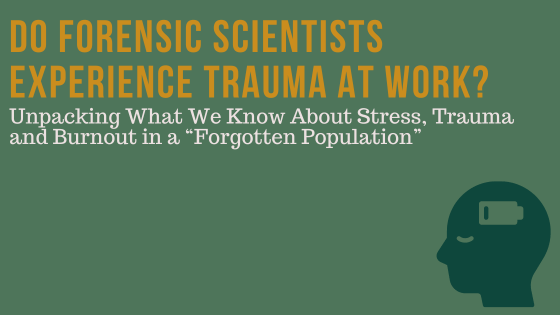Today’s blog is written and condensed by guest blogger Jordan Nutting. Reposted from The ISHI Report with permission.
For many years, research and efforts to mitigate workplace impacts on mental health and stress in the criminal justice system have almost exclusively focused on its non-civilian members. This makes good sense. Police officers, for example, carry service weapons, might find themselves making split second life-or-death decisions and work closely with crime victims and their families. In recent years, however, research on workplace trauma and stressors has expanded to include a “forgotten population” of people who might not directly interact with violence but who still encounter its impacts—forensic scientists (1).
Forensic scientists regularly handle the artifacts and intimate details of violent, disturbing crimes, from analyzing bloodstain patterns at the scene of an assault to prepping semen-stained clothing for DNA analysis. Though these are “secondhand” encounters with traumatic events, recent research indicates that forensic professionals’ workplace duties can lead to firsthand experience with vicarious trauma (VT). Other stressors that forensic scientists face, such as testifying in court, handling an ever-increasing backlog of casework samples and needing to produce “error-free” work are less graphic, but they are intense and can cause burnout. Altogether, the impacts of stress can have both subtle and outsized impacts on forensic scientists’ mental health and the quality of their work.
“I really didn’t like working calls with kids because I have three kids. I’d be devastated after those cases,” says Heidi Sievers, Ph.D., a former forensic investigator with the Pasco Sheriff’s Office in Florida who now is a bloodstain pattern analyst, teaches and runs a forensic consulting business. “I could see it even in something as little as my handwriting being terrible on those case reports. I just wanted to be done with it as soon as possible. That’s an avoidance mechanism that I didn’t know I was instilling at the time.”
During her time as a forensic investigator, Sievers also pursued doctoral research in criminal justice and law enforcement administration to study the impacts of stress in forensics investigators handling homicide and attempted homicide cases (2). Her research joins mounting evidence that points to the potentially harmful mental, emotional, physical and social impacts of forensic scientists’ line of work. For example, a 2016 survey-based study of over 899 forensic scientists funded by the National Institute of Justice (NIJ) found that approximately 10–20% of the respondents exhibited symptoms that overlap with symptoms of secondary traumatic stress, including nightmares, detachment and difficulty concentrating (3). Though those numbers may not fully capture the frequency or intensity of traumatic experiences or burnout in the field, they “highlight the impact of work with traumatic materials on forensic professionals,” says Andrew Levin, an associate professor of psychiatry at Columbia University. Levin co-authored a 2021 NIJ-funded study on traumatic stress experienced by forensics scientists (4).
As perhaps one of clearest signals that stress, trauma and burnout is a recognized issue for forensic scientists, a 2019 NIJ report listed “developing resources to address workforce stress and vicarious trauma associated with the forensic work environment” as a key need (5).
In light of this growing acknowledgement of the problem of stress and the growing body of research, it is important for members of the forensic science community to not only know what VT and burnout look like, but also to know what potential best practices can build resilience and protect wellbeing in their workplaces.
Defining Trauma and Burnout
Vicarious trauma was first described in the context of mental health therapists. It was found that therapists would experience negative, ongoing psychological changes due to working closely with clients who shared details of traumatic life experiences (1). By being exposed to these first-hand experiences with trauma, therapists’ own worldviews and views of themselves or others were impacted, creating a second-hand or vicarious trauma experience. The changes that come with VT—such as a new belief that the world is unjust—are “pervasive, cumulative and permanent.”
Another term that is related to, but distinct from, VT is secondary traumatic stress (STS). As noted in one literature review, VT typically refers to negative schema changes that arise from long-term, empathetic exposures to victims of trauma. In contrast, STS arises from sudden or extreme exposures to survivor accounts or details of a traumatic event, such as a mass disaster or a mass shooting (1). Unlike VT, which causes changes in a person’s worldview, STS gives rise to symptoms that are almost identical to PTSD symptoms, such as hypervigilance or avoidance. Indeed, the American Psychiatry Association lists “first-hand or extreme exposure to aversive details of the traumatic event” through workplace duties in the diagnostic criteria for PTSD.
Once VT and STS were identified as risks for psychiatric professions, trauma research was extended to other “helper” professions, particularly for first responders to mass casualty events, police officers, fire fighters and emergency room workers. However, it is only within the past decade that trauma in forensic professionals has been explored (4). Though a lab analyst or crime scene investigator may not directly interact with victims of a crime, they often face repeated exposure to graphic details of traumatic events, such as physical evidence or case notes. Because of the more removed nature of forensic work, current studies suggest that VT, rather than STS, is the form of trauma most experienced by forensic professionals. However, STS has been identified in crime scene investigators, who are more likely to encounter victims and witnesses (1).
Burnout, which is another important marker of stress, is distinct from trauma. Instead of arising from an experience with a traumatic event, burnout has more to do with the day-to-day pressures of a person’s workplace (1). In the case of forensic scientists, these pressures can be intense. Forensic scientists need to work quickly and accurately, creating a pressure for their work to be “error free” that many then must defend in court. Huge casework backlogs can cause feelings of inadequacy or ineffectiveness. Workplace cultures may keep people from processing challenges in a positive way.
“I encountered this toxic notion that there’s no crying in law enforcement. There’s this sense that if you do, can you really handle the job?” says Sievers.
Another challenge that forensic professionals may face is that they don’t receive the same coping support as sworn officials like police offers. Sievers notes that in her precinct, forensic team members were rarely invited to case debriefings, preventing a sense of closure.
In general, burnout leads to job dissatisfaction, detachment and cynicism. In Sievers’ case, she found herself avoiding, becoming less efficient and focused:
“I had been a go-getter, but the job weighed on me. I slowed down, I would call in more.”
What are the Solutions?
In the criminal justice system, where the ability to assess information, make decisions and act efficiently is crucial, stress can have broadly negative implications for an organization’s effectiveness (1). However, forensic scientists’ professional duties cannot change to avoid potential causes of trauma or burnout: violent crimes will still occur, there will still be a casework backlog, and not all personal triggers can be avoided.
Instead, Sievers and Levin both emphasize that resources and solutions need to be in place to foster resilience to work stress and to support those who are impacted. But what types of support are the most effective?
In her research, Sievers found that having strong emotional support and interpersonal bonds at work was the most effective way to combat stress and burnout among forensic scientists. In other words, the best coping strategy was being able to talk about challenging experiences with a co-worker. Though she would also like to see organizations normalize individual counseling and consistently include forensic investigators in debriefings, Sievers’ main recommendation for anyone entering the field is to seek out a peer who can be trusted with sensitive, personal information.
Research also points to the important role organizations can play in mitigating stress in forensic scientists. Levin co-authored a study where over 400 forensic science professionals were surveyed for trauma and burnout symptoms and their perceptions of how their organizations were addressing these challenges (5).
“In our study, there was a strong correlation between workers’ resilience and the belief that their organization was actively attending to issues of stress and trauma,” says Levin.
These results not only emphasize that organizations should take steps to combat stress, but that they should actively promote and communicate relevant resources to employees.
One resource that can help organizations identify ways they can support their forensic employees is the Office for Victims of Crime’s Vicarious Trauma Toolkit. Though this toolkit was originally designed to support first responders and other professions at risk of VT, Levin notes that it is a useful tool for forensic professionals as well. The toolkit helps organizations assess specific areas where they can build organizational health and provides guidance for implementing trauma-informed practices. The NIJ Forensic Technology Center of Excellence has also gathered a collection of webinars, podcasts and resources on combatting stress and trauma that is geared specifically for forensic scientists.
Though the specific responsibilities of individuals and organizations in combating stress are distinct, the overall goal is to build greater awareness of the problem and to make sure that people know what resources are available when they inevitably encounter stressful experiences.
“People in forensics need to be aware that trauma and burnout is going to happen and have a plan in place,” says Sievers. “The biggest mistake I made going into the field was thinking that nothing was going to bother me.”
Want to learn more about trauma and resilience? Allison Massari, who survived being burned alive in a 1998 car fire, will share her personal story of strength and healing in the keynote address at ISHI 34.
References
- Slack, D. P. (2020) Trauma and coping mechanisms exhibited by forensic science practitioners: A literature review. Forensic Sci. Int.: Synergy 2, 310. doi: 10.1016/j.fsisyn.2020.10.001
- Sievers, H. M. (2020) Aspects of Homicide/Attempted Homicide Investigations and Forensic Investigator Stress. PhD thesis, Capella University.
- Holt, T. J. et al. (2016) Examination of the conditions affecting forensic scientists’ workplace productivity and occupational stress. https://www.ojp.gov/pdffiles1/nij/grants/250233.pdf
- Levin, A. P. et al. (2021) Secondary traumatic stress, burnout, compassion satisfaction, and perceived organizational trauma readiness in forensic science professionals. J. Forensic Sci. 66, 1759. doi: 10.1111/1556-4029.14747
- U.S. Department of Justice. (2019) Report to Congress: Needs Assessment of Forensic Laboratories and Medical Examiners/Coroner Offices. https://nij.ojp.gov/library/publications/report-congress-needs-assessment-forensic-laboratories-and-medical
WOULD YOU LIKE TO SEE MORE ARTICLES LIKE THIS? SUBSCRIBE TO THE ISHI BLOG BELOW!
SUBSCRIBE NOW!



